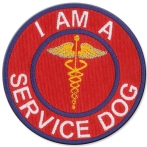Service Dog Training

The Americans with Disabilities Act does not provide guidelines for service dog training. As long as a dog is trained to perform tasks for people with physical or other challenges, he or she is considered a service dog.
Therefore, if you have a disability and your dog performs a particular task for you on a regular basis, such as pick up dropped items or help you walk, your dog is legally considered a service dog.
The certification of service dogs is not required and there is no central or national mechanism for sanctioning or licensing aide dogs. Though, organizations such as Assistance Dogs International (ADI) and the International Association of Assistance Dog Partners (IAADP) have set training standards for service dogs.
For example, according to the IAADP's minimum training standards, an assistance dog should be given a minimum of 120 hours of schooling over a period of six months or longer, master basic obedience skills, and acquire proper social behavior skills.
The characteristics and behaviors of service dogs vary, but these minimum standards are guidelines that service dog owners can look to in order to determine how much training their dogs need.
Once you decide that you want a service dog and determine what you need your dog to do for you, it's time to begin the process of choosing a dog. You can either work with a service dog training program to acquire a dog (through a purchase or donation) or train your own dog.
If you want to train your own dog and have no experience, you need to hire a dog training specialist. Also, if you’re planning to train your own dog, expect to first spend at least 30 days with the dog to determine whether or not he or she is a good fit for the tasks required
Good-natured dogs that are healthy, strong, trainable, and docile tend to make the best aide dogs.
There are several advantages to training your own service dog (or working with a trainer directly). You don’t have to get on a waiting list to receive a service dog. It may be less expensive to train the dog yourself and you can train him or her to meet your specific needs.
The downside of training your own service dog is that the process is immensely time-consuming. Furthermore, if you’re training a puppy, you will have to wait until he or she grows up and gets stronger before teaching more complex tasks, like bracing or pulling a wheelchair.
For more information on service dogs, click here.
References: http://www.iaadp.org/iaadp-minimum-training-standards-for-public-access.html, http://www.assistancedogsinternational.org, http://www.ada.gov/svcanimb.htm
Related Information
Types of Service Dogs
Requirements for Training Aide Dogs
Certification - Is it Necessary?
Tips and Resources for Finding Training Schools
Service Dog Supplies
Back to Mobility Advisor HOME from Service Dog Training
Popular ArticlesTypes of Mobility Chairs Wheelchair Sports Activities Helpful Resource Organizations Mobility Scooter Buying Tips Portable Ramp Options |


